The Best DOS Driving Games - Part 4
12th November 2023
Welcome to this fourth and final part of the best driving games on the DOS platform which covers 1996-1998. We've come a long way and seen some amazing titles, but things can only get better...
At the start of this period, anyone with a new PC had a Pentium, AMD K5 or Cyrix 6x86 with 16 MB of RAM, bus speeds were 60 MHz or 75 MHz, and 3D graphics technology got a serious boost with the 3dfx Voodoo card. Super Socket 7 was just around the corner which further stretched the PC bus to 100 MHz and the AMD K6 and Pentium II arrived. To reach the highest performance in games, graphics number crunching was offloaded to 2D/3D accelerator cards, where the market was at its most aggressive. ATI, nVidia, S3 and Matrox were all competing for your hard-earned dollars.
As we saw in Part 3, games were starting to move to Windows 95 with support for DirectX, OpenGL and other graphics APIs running on a Pentium MMX, Pentium II or fast Super Socket 7 chip like the AMD K6-2. By 1998, a PC would have anywhere from 32 MB to 128 MB of SDRAM and a graphics accelerator card with 16 MB of onboard video memory. This really opened the door to higher gaming resolutions with fast frames per second.
Here's the list of driving games we'll explore in this segment:
Part 4 - 1996-1998
|
Destruction Derby 2 (Psygnosis, 1996)
Reflection Interactive were back in October 1996 with the follow-up to the well-liked smash 'em up, Destruction Derby. This one offered more of the same, but with better graphics and sound, better handling of the cars and nicer tracks.
The aim of the game remained as before: to smash your way through the competition into first place.
 One criticism I had with Destruction Derby was that while collisions resulted in pieces of car flying all over the place, those pieces never seemed to remain on the ground and your car never looked like half a car after a dozen oopsies with other vehicles or the track side. After all, part of the fun with a 'smash 'em up like this is to actually visualise the damage, right? Reflection listened but didn't fully obey. In DD2, your vehicle can lose its body parts like wheels and bonnet, and can even end up on its roof, leaving you prone to further crashes from other cars. This is better (and there is some road debris), but still doesn't go far enough. Your car can now take jumps and end up airborne, though the gravity is absurdly low - still it adds something to the game.
One criticism I had with Destruction Derby was that while collisions resulted in pieces of car flying all over the place, those pieces never seemed to remain on the ground and your car never looked like half a car after a dozen oopsies with other vehicles or the track side. After all, part of the fun with a 'smash 'em up like this is to actually visualise the damage, right? Reflection listened but didn't fully obey. In DD2, your vehicle can lose its body parts like wheels and bonnet, and can even end up on its roof, leaving you prone to further crashes from other cars. This is better (and there is some road debris), but still doesn't go far enough. Your car can now take jumps and end up airborne, though the gravity is absurdly low - still it adds something to the game.
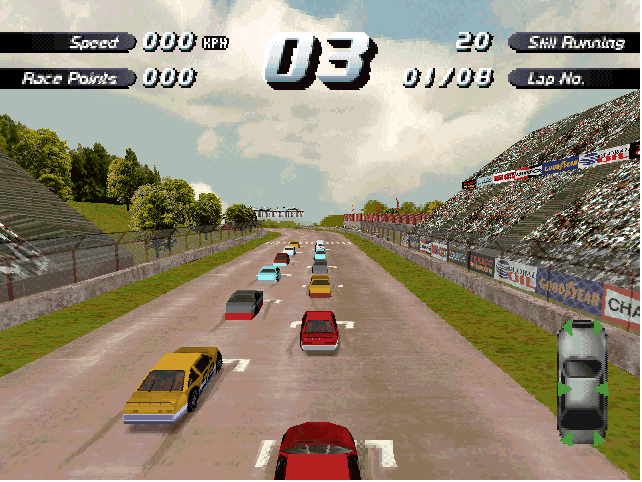 Gameplay I feel is a mixed bag. The pace is good and you can feel yourself tensing up throughout a race, so there is a definite atmosphere to it. The graphics are slightly better than the original - it runs in 640 x 480 but somehow comes across more blocky than other games we've seen. The tracks, of which there are seven, range from just okay to pretty great. The later ones add some variety and offer good challenges, including jumps, tunnels and forks where you can choose to take one path or another, which often ends up in a crash where they cross over.
Gameplay I feel is a mixed bag. The pace is good and you can feel yourself tensing up throughout a race, so there is a definite atmosphere to it. The graphics are slightly better than the original - it runs in 640 x 480 but somehow comes across more blocky than other games we've seen. The tracks, of which there are seven, range from just okay to pretty great. The later ones add some variety and offer good challenges, including jumps, tunnels and forks where you can choose to take one path or another, which often ends up in a crash where they cross over.
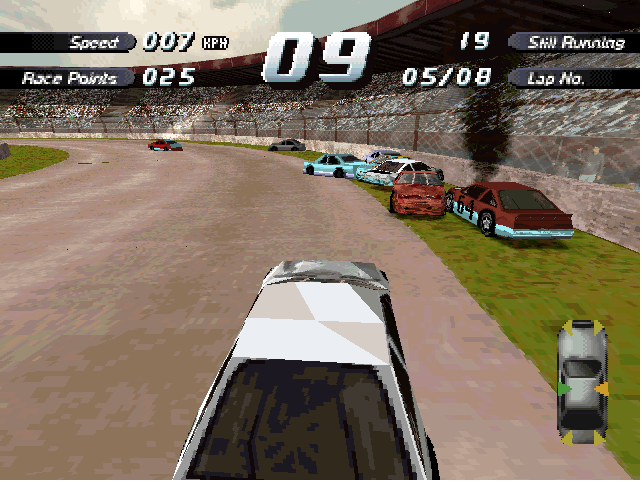 Destruction Derby 2 is a pretty tough game - at least, it starts out that way. As a beginner you'll probably go for the 'Rookie' car, but here the competition are just too difficult to overtake. I went through an entire Championship in this mode, and discovered that even if you know the tracks well, the other cars seem much better than you at taking corners and with its slow acceleration you'll struggle to win. Strangely, however, you sometimes get lucky and pass an accident that just occurred, and you make up a bunch of positions by just avoiding the carnage. This happened a lot - you could be in 17th position and after five more laps you're in 3rd because ahead of you there have been some 'disagreements' - just don't plough into them like everyone else has!
Destruction Derby 2 is a pretty tough game - at least, it starts out that way. As a beginner you'll probably go for the 'Rookie' car, but here the competition are just too difficult to overtake. I went through an entire Championship in this mode, and discovered that even if you know the tracks well, the other cars seem much better than you at taking corners and with its slow acceleration you'll struggle to win. Strangely, however, you sometimes get lucky and pass an accident that just occurred, and you make up a bunch of positions by just avoiding the carnage. This happened a lot - you could be in 17th position and after five more laps you're in 3rd because ahead of you there have been some 'disagreements' - just don't plough into them like everyone else has!
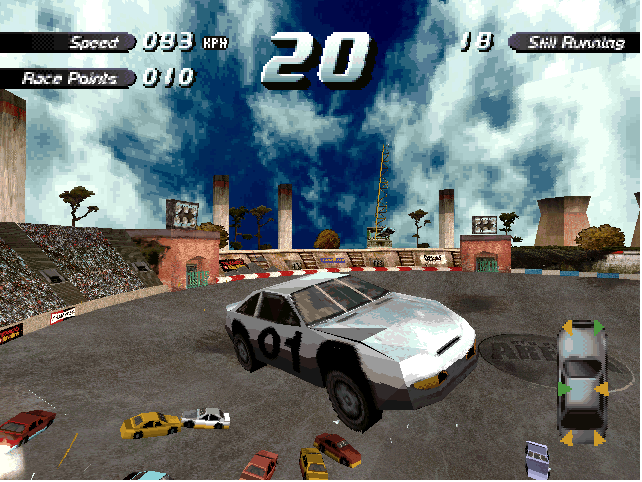 I found the game actually easier to play on the Pro car - despite its lack of grip it has much better acceleration so you can catch up to the pack more quickly. You can also do power slides in this car but be careful not to go into a sharp corner too fast and then slam on the brakes as you'll suffer from lift-off oversteer. It's examples like this that demonstrate some of the changes in the car's physics model.
I found the game actually easier to play on the Pro car - despite its lack of grip it has much better acceleration so you can catch up to the pack more quickly. You can also do power slides in this car but be careful not to go into a sharp corner too fast and then slam on the brakes as you'll suffer from lift-off oversteer. It's examples like this that demonstrate some of the changes in the car's physics model.
Sadly the static menu screens are at best boring and at worst non-intuitive or buggy. Entering your name using the cursor keys and enter isn't fun for a PC game, just time-consuming. Viewing lap times only shows the fastest five times for each track, so unless you're extremely good, you can't tell how far off the top you are. And when you reload from a saved game in order to go back to the Division you're in (you need to do this to unlock certain tracks) it forces you into the next race rather than returning you to the menu to choose what you want to do. Opting for multiplayer you have to enter your name, but then hitting [END] just reverts you back to entering your name. These screens could do with some textual feedback, like when you save actually print up a 'Game saved' message rather than just beeping. Oh, and there there's no music even though the menu has a CD Player option.
So it's not the groundbreaking sequel I was hoping for, but that doesn't mean you shouldn't give it some time. It's very fun to play, especially the racing circuits - I wouldn't spend much time in the derby itself as it's just too difficult.
Sound: Good engine roar and you do hear other cars as there are within earshot. I couldn't get music working though. 7/10
Gameplay: Despite the negative points I mentioned, I strangely kept going back to play this again and again. And it wasn't so much for the crashes - I love the fact that you can inadvertently go from middle of the pack to front runner purely because of the other drivers crashing and all you need to do is avoid the pile-up - it's fairly common. The championship layout is confusing, with different leagues you get promoted into or relegated from depending on your performance, but the points system doesn't make much sense - it's all rather disjointed as a game, like they added all these things at the 11th hour around a 3D driving game. The crazy destruction derby itself is highly disappointing compared to the track races - in 'Total Destruction' all the other cars aim straight for you - you really don't stand a chance, so what's the point in putting it into the game?! It's not clever or fun - having the ability to switch views so you could see to your sides or rear would have been a good idea, so you could plan your strategy a little more. 7/10
Lastability: On the face of it, it's a disappointing game with poor menu layout and a disjointed and confusing championship mechanism that doesn't give you a real sense that you're progressing. But there is enough in there to keep you going back to it, to learn the tracks and the behaviour of the other cars. 8/10
OVERALL: 7.5/10
Grand Prix 2 (MicroProse, 1996)
After the critically-acclaimed Formula One Grand Prix (World Circuit), MicroProse returned with its successor in 1996. It's important for such a sequel to retain all the things that made the first one so good, and MicroProse did just that. Almost everything in Grand Prix 2 is the same but is significantly more polished.
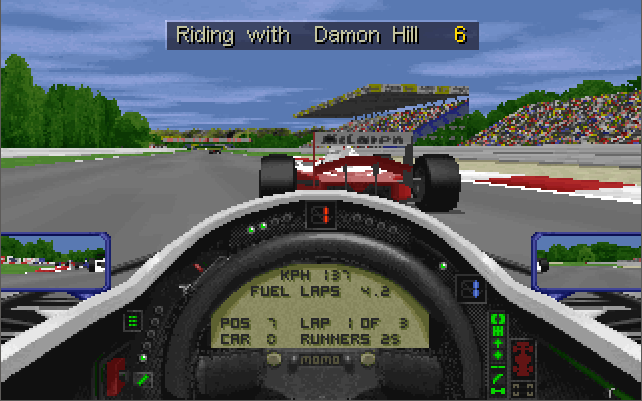 This time around, MicroProse secured the licence from the FIA to use the actual team and driver names of the 1994 Grand Prix season, meaning you get to see all the period-correct cars with their sponsorship liveries, teams and drivers where even their helmets are depicted correctly.
This time around, MicroProse secured the licence from the FIA to use the actual team and driver names of the 1994 Grand Prix season, meaning you get to see all the period-correct cars with their sponsorship liveries, teams and drivers where even their helmets are depicted correctly.
The game supports all the popular sound cards of the time including Sound Blaster/Pro/16/AWE32, ESS AudioDrive, ProAudio Spectrum, Sound Master 2, Gravis UltraSound/Max, and Microsoft Sound System.
 You will instantly be familiar with the menu system as it's laid out much like the first game, though it can now also be driven with a mouse. Just as with F1GP, there's a lot you can do in the various menus but it's all laid out very logically.
You will instantly be familiar with the menu system as it's laid out much like the first game, though it can now also be driven with a mouse. Just as with F1GP, there's a lot you can do in the various menus but it's all laid out very logically.
A Quick Race option is there if you just want to get right into the action without going through practice or qualifying sessions first. All the circuits are available from the game's startup - there's nothing to 'unlock' in GP2. This allows novice drivers to get used to the car physics, and with the driving aids able to be switched off and on in real time without penalty, the game is extremely accessible to all. As you feel able to, you can learn to drive without the driving aids and see the impact it can have on your lap times.
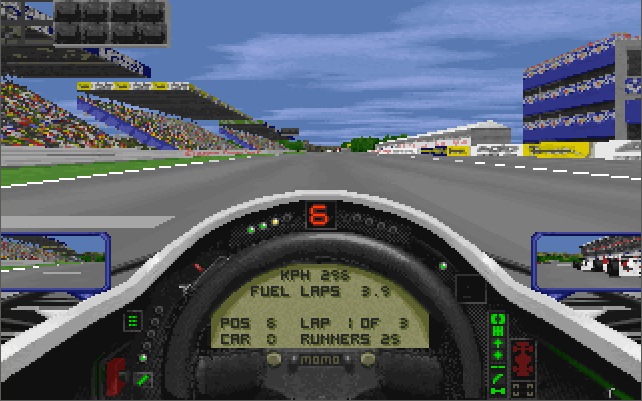 Alternatively you can practice on any circuit, do a non-championship race (with practice and qualifying sessions), or enter the full championship season from the start.
Alternatively you can practice on any circuit, do a non-championship race (with practice and qualifying sessions), or enter the full championship season from the start.
True to real life, during practice and qualifying sessions you will see other cars out on the circuit doing the same as you, and you can switch the view to any other car at any time to see what they're up to.
 Grand Prix 2, like its predecessor, shines not only for its gameplay but also its attention to detail. Even doing a quick race of 3 laps provides you with a good amount of post-race analysis so you can check your lap times against the other drivers for the race, as well as against the historical records set on that track. There is a tremendous amount of detail in the car setup portion of the game if you want to delve more deeply in the car physics aspect, and any car setup can be saved and restored. This is especially useful in the Championship, where you would have a different car setup for each track.
Grand Prix 2, like its predecessor, shines not only for its gameplay but also its attention to detail. Even doing a quick race of 3 laps provides you with a good amount of post-race analysis so you can check your lap times against the other drivers for the race, as well as against the historical records set on that track. There is a tremendous amount of detail in the car setup portion of the game if you want to delve more deeply in the car physics aspect, and any car setup can be saved and restored. This is especially useful in the Championship, where you would have a different car setup for each track.
There are five difficulty levels which affect the standard of the opposition, and just as with F1GP you can opt to have this standard spread across all cars, set to 1994 levels, or randomly spread. Something new in GP2 is car component failures - in the 'Car Realism' menu you can choose to switch on up to eight different component failures that may strike during a race.
Sound: Highly authentic Grand Prix engine sounds and excellent sound card support, but there's no music (not that I'm too bothered by this). If there's anything I would recommend, adding speech like when pitting and perhaps some background noise would have been nice. 7/10
Gameplay: I cannot find fault with anything in GP2 regarding its gameplay. The full race season from 1994 is there, and the options to analyse your performance, tweak the car, save/load your settings are very welcome. With the actual teams, drivers, accurate circuits, and a rich set of options, there's little point in ever returning to F1GP once you've played GP2 - it's an all-round better game but manages to keep everything that made its predecessor the #1 title it was - well done MicroProse! 10/10
Lastability: As mentioned, it's highly accessible for beginners, but has a ton of depth to open up at your leisure as your proficiency grows. Grand Prix 2 is a top-flight title for racers of all levels. 10/10
OVERALL: 9/10
The Need for Speed: Special Edition (Electronic Arts, 1996)
 The Need for Speed SE was not much more than a dedicated Windows version of NFS from the year before. Given that it ran in Windows 95, it was able to make use of DirectX 2.0 for higher performance. It was released only on CD-ROM, since this was becoming the standard medium at the time, and on the CD you got both the original DOS version and the new Windows version.
The Need for Speed SE was not much more than a dedicated Windows version of NFS from the year before. Given that it ran in Windows 95, it was able to make use of DirectX 2.0 for higher performance. It was released only on CD-ROM, since this was becoming the standard medium at the time, and on the CD you got both the original DOS version and the new Windows version.
The NFS SE came with two extra tracks over the DOS version: Transtropolis and Burnt Sienna, and you got in-game music which wasn't possible on NFS.
 The game came with the same eight exotic cars that featured in NFS, and the car handling remained unchanged also.
The game came with the same eight exotic cars that featured in NFS, and the car handling remained unchanged also.
The Need for Speed SE comes across as a little dated now, given that we are getting games with more variety in the physics engine, and while the landscape graphics are pretty decent, this game was nothing more than a mildly breathed on revision on The Need for Speed. The game intro has been updated and looks nice, and overall the game plays well.
More cars (or different ones) would have been a nice touch to add some variation between the two games, and certainly more than the two additional locations, even though they are both good. Given that it's a little bit better and does run in DOS as well, it made sense to buy this game if you didn't already own the original, but there's not enough here to make it a worthwhile second purchase.
Sound: Good music and sound effects, but apart from the intro sequence, these are the same as the original. 8/10
Gameplay: A couple of extra locations to race around, and these are nice. The multiplayer option is also still there, with both modem and direct connection available. 7/10
Lastability: As with the original game, NFS SE . 5/10
OVERALL: 7/10
NASCAR Racing 2 (Papyrus, 1996)
 NASCAR Racing 2 arrived in December 1996, with Papyrus this time agreeing to have Sierra Online publish the game. The Papyrus team went back to the drawing board for this title with a brand new game engine that now supported hardware 3D acceleration. Unlike NASCAR Racing, NR2 came in both DOS and Windows versions.
NASCAR Racing 2 arrived in December 1996, with Papyrus this time agreeing to have Sierra Online publish the game. The Papyrus team went back to the drawing board for this title with a brand new game engine that now supported hardware 3D acceleration. Unlike NASCAR Racing, NR2 came in both DOS and Windows versions.
Focussing on the full 1996 NASCAR season, the game featured all the actual teams, drivers, and cars. 13 tracks are included but in addition these are broken down into specific 'events' like the Die Hard 500 at Talladega or the Goodrench Service 400 at Michigan Speedway - having more than just the basic tracks is a really nice touch.
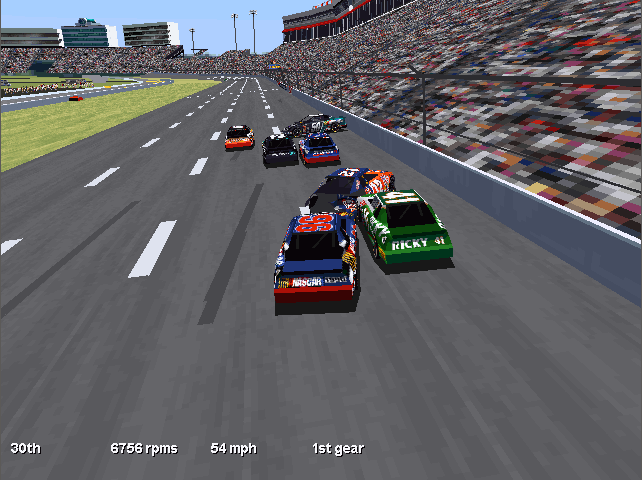 The game supports all the major sound cards for 1996 including Ad Lib Gold, ESS AudioDrive, Ensoniq SoundScape, AMD Interwave-based cards, Microsoft Sound System, nVidia(?), Roland RAP-10, Sound Blaster/Pro/16, Tempo, Turtle Beach Multisound and WaveJammer. You hear a ton of speech from your spotter who informs you of all track events and where to position your car, which is a great addition, and the overall engine roar of cars in your vicinity really makes NR2 a more immersive experience.
The game supports all the major sound cards for 1996 including Ad Lib Gold, ESS AudioDrive, Ensoniq SoundScape, AMD Interwave-based cards, Microsoft Sound System, nVidia(?), Roland RAP-10, Sound Blaster/Pro/16, Tempo, Turtle Beach Multisound and WaveJammer. You hear a ton of speech from your spotter who informs you of all track events and where to position your car, which is a great addition, and the overall engine roar of cars in your vicinity really makes NR2 a more immersive experience.
Just as before, you get to choose from either a single race or the full championship, both which will take you through the various segments of practice, qualifying/warm-up and the race. New to NR2 is an option to enable Arcade mode in both the 'Driving Mode' and 'Damage' race options, which help noobies get used to how the car handles with less frustration.
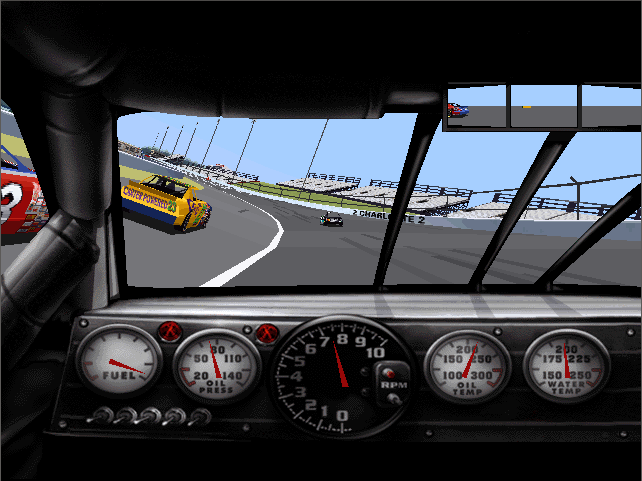 It's not an easy game to play and will require some time learning how to setup your car for each track to maximise your speed and grip, but there's plenty of help on the internet to guide you in this. NR2 is definitely better when played with an analogue joystick. Even better would be a steering wheel and pedals, which were not directly supported by the game but you can easily map these to the various steering, acceleration and braking controls. You should avoid scrubbing your tyres around the bends and this is where using analogue controls will certainly help you feed in the right amount of input.
It's not an easy game to play and will require some time learning how to setup your car for each track to maximise your speed and grip, but there's plenty of help on the internet to guide you in this. NR2 is definitely better when played with an analogue joystick. Even better would be a steering wheel and pedals, which were not directly supported by the game but you can easily map these to the various steering, acceleration and braking controls. You should avoid scrubbing your tyres around the bends and this is where using analogue controls will certainly help you feed in the right amount of input.
 NASCAR Racing 2 will run on a fast clock-doubled 486 but is best run on a Pentium 120 or faster with at least 16 MB of RAM. Because of the 3D hardware acceleration features of the new engine, it's also best played with a Rendition 3D graphics card. It will however, still run on any 320 x 200 VGA card.
NASCAR Racing 2 will run on a fast clock-doubled 486 but is best run on a Pentium 120 or faster with at least 16 MB of RAM. Because of the 3D hardware acceleration features of the new engine, it's also best played with a Rendition 3D graphics card. It will however, still run on any 320 x 200 VGA card.
In November 1997, an expansion pack for the game arrived. Called the Grand National Series Expansion Pack, this added 10 more tracks and the top ten drivers from the Busch Grand National Series (a 'tier 2' series organised by NASCAR and sponsored by Anheuser-Busch where the main 'tier 1' series is the 'Cup').
Sound: Again, just amazing - Papyrus have nailed the sounds of the NASCAR spectacle with the deep roars from the engines to the spotter speaking to you to let you know where to be on the track or if there's another car close by, or an accident ahead.10/10
Gameplay: NR2 isn't for everyone. Personally I prefer the variety of Formula One circuits rather than the ovals of NASCAR, but looking objectively at this game, it has everything a NASCAR fan could want in a game - great graphics, sound, realism, immersion and decent AI for the other cars. A worthy sequel that does everything just a little better. 10/10
Lastability: With many events to choose from, or the full 1994 Championship to compete in, NR2 will occupy you for quite some time. When you're done with that, don't forget the multiplayer options that include 2-player modem or direct connection over null modem cable, or 8-player network play (IPX/SPX only, not TCP/IP). 10/10
OVERALL: 10/10
Network Q RAC Rally Championship (Europress, 1996)
Magnetic Fields were brought in to develop Europress' follow-up to the pretty good Network Q RAC Rally back in 1993. This game was also sold under the title of Rally Championship: International Off-Road Racing and Rallye Racing 97.
 This was the first rally title to use fully 3D models and it shows - the game looks just beautiful, from the amazing detail on the cars themselves to the awesome scenery. And when you factor in the weather conditions that range from rain, fog, snow, and day/night segments, you can tell Magnetic Fields put a lot of dedication into perfecting this to be as immersive and realistic as possible.
This was the first rally title to use fully 3D models and it shows - the game looks just beautiful, from the amazing detail on the cars themselves to the awesome scenery. And when you factor in the weather conditions that range from rain, fog, snow, and day/night segments, you can tell Magnetic Fields put a lot of dedication into perfecting this to be as immersive and realistic as possible.
You get to choose from one of six rally teams and their cars: the Subaru Impreza, Ford Escort RS Cosworth, Renault Maxi Megane, VW Golf GTi 16V, Skoda Felicia, and Proton Wira, all of which are displayed in lovely detail. The game contains all of the 1995 Network Q RAC Rally's 28 segments. These are all based in the UK and range from forest and gravel tracks to tarmac roads, some of which are snow-covered!
 Unlike its predecessor you can jump straight to any part of the rally if you just want to test your mettle against the later segments and try and get the fastest time. The part of the rally is chosen by opting for 'Arcade Level 1' through 'Arcade Level 5' (since the stages get more and more difficult toward the end of the rally). On these later stages just reaching the next checkpoint before the timer runs out is very difficult without a lot of practice and car tuning.
Unlike its predecessor you can jump straight to any part of the rally if you just want to test your mettle against the later segments and try and get the fastest time. The part of the rally is chosen by opting for 'Arcade Level 1' through 'Arcade Level 5' (since the stages get more and more difficult toward the end of the rally). On these later stages just reaching the next checkpoint before the timer runs out is very difficult without a lot of practice and car tuning.
You can change the viewpoint from which you drive by pressing F1 at any time - this switches you from cockpit view, to outside (bonnet) view, to a chase view. Other function keys will change the screen size, the amount of draw distance, rear-view mirror on/off, resolution (normal or high), tacho display, messages/signs on/off, information overlay on/off, and visual effects on/off. This allows you to play the game on lesser hardware if you're struggling fps-wise.
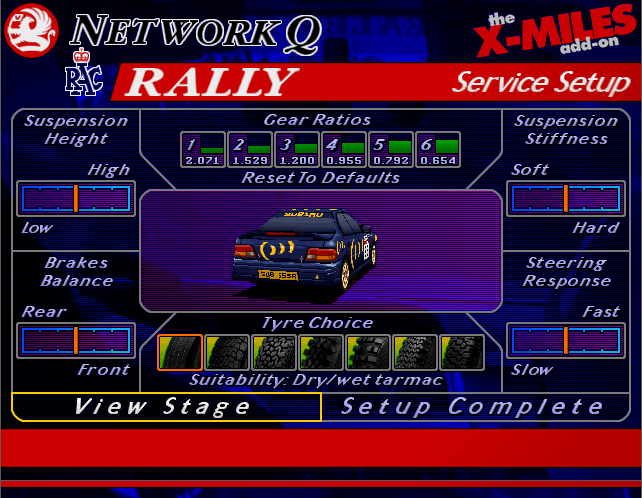 The AI of computer-controlled drivers can also be adjusted from a skill level of 1 through 4. This changes the drivers' aggressiveness and overall intelligence. There's also a lot of car setup you can perform between rally stages, including suspension settings, brake balance, gear ratios, tyre selection and the amount of fuel to carry.
The AI of computer-controlled drivers can also be adjusted from a skill level of 1 through 4. This changes the drivers' aggressiveness and overall intelligence. There's also a lot of car setup you can perform between rally stages, including suspension settings, brake balance, gear ratios, tyre selection and the amount of fuel to carry.
The music in the game is pumping, with six tracks to choose from on your CD player as you drive, though I prefer to switch off the in-game music in the game options. Your navigator verbally calls out the next hazard or bend, and the sound of your car as you slide around on gravel or crunching over hard-packed ice on a snow trail is really good. Sadly you don't hear much noise from the other cars around you.
The overall gameplay is very arcade-like, and easy to get hang of, though you do notice car setup changes when they are applied, making the game a little more extensible than a typical flat-out arcade racer.
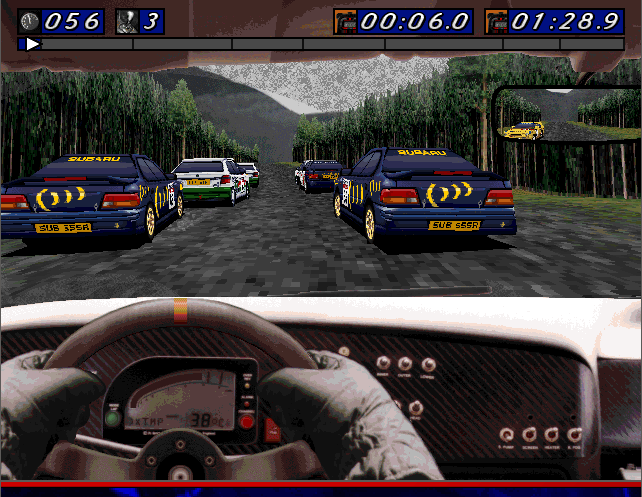 Collide with something too heavy and you'll end up rolling your car! Any damage you sustain should be repaired after each stage or the car's handling will deteriorate. The damage model is rather extensive, with everything from engine cooling and electrical problems to gearbox, exhaust, brakes, steering, and even your lights!
Collide with something too heavy and you'll end up rolling your car! Any damage you sustain should be repaired after each stage or the car's handling will deteriorate. The damage model is rather extensive, with everything from engine cooling and electrical problems to gearbox, exhaust, brakes, steering, and even your lights!
The game will run on a fast 486DX/2 with 8 MB of RAM, but it's best on a Pentium with a decent SVGA PCI graphics card. As with most driving games, use an analogue joystick or these days, a steering wheel for the more authentic experience.
In 1997, Europress released an expansion pack for Network Q RAC Rally Championship called the X-Miles add-on. This added a further 10 segments outside of the UK with desert and wide open areas on dirt.
Sound: Great speech cues from your navigator just like in a real rally. The road noise changes depending on the surface type (quieter on tarmac, 'gravelly' on gravel, crunchy on snow, etc - really nice! Decent engine sounds and gear change snicks - nothing to complain about here. If you like in-game music the choices are also good. 8/10
Gameplay: RAC Rally Championship is the best rally game you can get (for its time) - it plays really well, can be a real challenge in the later stages but is easy to get into, and there's lots you can focus on such as repairing damage and tweaking your car. Overall, it's a fun and accessible experience. The only minor niggle I have is the invisible barriers on each side of the road that bounce you off - would have been nice to have more room on the road edges and the barrier to match up with the scenery. 7.5/10
Lastability: With the full complement of rally stages at your disposal, there's a lot in this game, but to go one better with an expansion pack is the icing on the cake, I love expansion packs! 8/10
OVERALL: 8/10
Screamer 2 (Virgin, 1996)
Publisher Virgin Interactive switched developers for the second Screamer game, this time being written by Milestone instead of Graffiti. The game is still an arcade racing game but the high-performance sportscars have been replaced by rally cars.
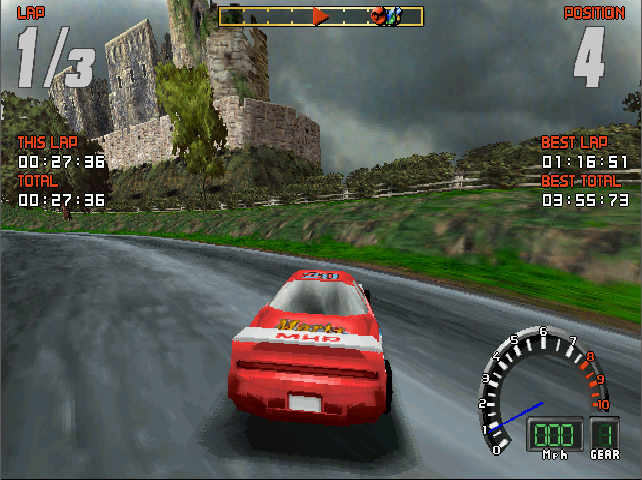 You choose from four teams, which really does nothing more than determine your car's colours. You then select the car you want to drive: Horizon or Nebula (both 120 mph 4WD cars), Spark (a 121 mph FWD car), or Radiance (a 122 mph RWD car). It's best to start with one of the 4WD (four wheel drive) cars, as you'll certainly get more grip. The Spark will understeer quite a lot, while the Radiance with lose the back end around corners. The variations here are really nice, and extend the game's learning curve in a similar way to a realism setting in other games.
You choose from four teams, which really does nothing more than determine your car's colours. You then select the car you want to drive: Horizon or Nebula (both 120 mph 4WD cars), Spark (a 121 mph FWD car), or Radiance (a 122 mph RWD car). It's best to start with one of the 4WD (four wheel drive) cars, as you'll certainly get more grip. The Spark will understeer quite a lot, while the Radiance with lose the back end around corners. The variations here are really nice, and extend the game's learning curve in a similar way to a realism setting in other games.
There are only three locations to choose from at the start: England, Egypt, or California. England is the easiest of these with well defined corners. Egypt is more tricky, as it's on sand and it's harder to see where the 'road' is going and it gets narrow in places with a fork. California is another tough track with its twists, roadworks to avoid and a change from tarmac to mud.
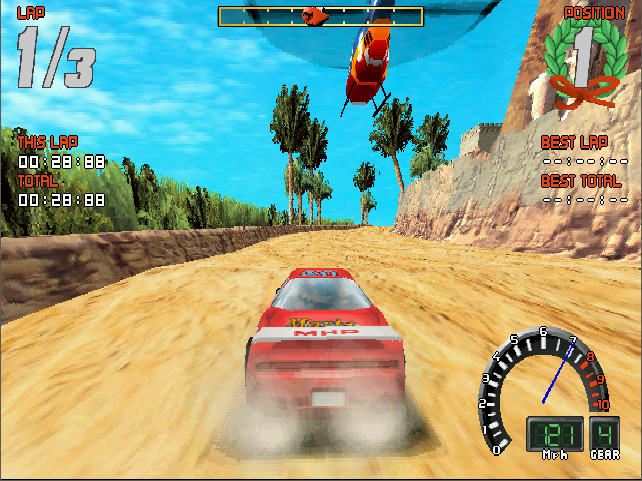 Competing in the Championship will pit you against the same three other racers, but as you progress you will race on two other tracks: Finland and Columbia. A very nice feature in Championship mode is the ability to customize your car setup, with handling, brakes, suspension, tyre type and tyre pressure. These can be saved to disk and recalled, giving you the ability to create a car that's ideal for the location and road surface.
Competing in the Championship will pit you against the same three other racers, but as you progress you will race on two other tracks: Finland and Columbia. A very nice feature in Championship mode is the ability to customize your car setup, with handling, brakes, suspension, tyre type and tyre pressure. These can be saved to disk and recalled, giving you the ability to create a car that's ideal for the location and road surface.
Screamer 2 is a difficult game. Racing against the three other computer-controlled players soon shows you that this isn't a game for instant gratification, but give it 30 minutes or so and you'll be winning races.
 The game requires a pretty high-end PC for 1996 - a Pentium for sure, and 16 MB of RAM. The game runs in one of four graphics configurations: two in 320 x 200 and two in 640 x 480 resolution, each also offering a 256-colour mode or a 65535-colour mode. There's not a massive difference between these colour depths in the game (both are lovely), but having these options means the game can be played on lesser hardware if that's all you have. The colour depth option is selectable at the time of installation so if you don't need the deeper-coloured textures of the 64K modes, you don't need to install them. There are two patches that allow the game to run using 3D hardware acceleration on a 3dfx Voodoo or Voodoo 2 card.
The game requires a pretty high-end PC for 1996 - a Pentium for sure, and 16 MB of RAM. The game runs in one of four graphics configurations: two in 320 x 200 and two in 640 x 480 resolution, each also offering a 256-colour mode or a 65535-colour mode. There's not a massive difference between these colour depths in the game (both are lovely), but having these options means the game can be played on lesser hardware if that's all you have. The colour depth option is selectable at the time of installation so if you don't need the deeper-coloured textures of the 64K modes, you don't need to install them. There are two patches that allow the game to run using 3D hardware acceleration on a 3dfx Voodoo or Voodoo 2 card.
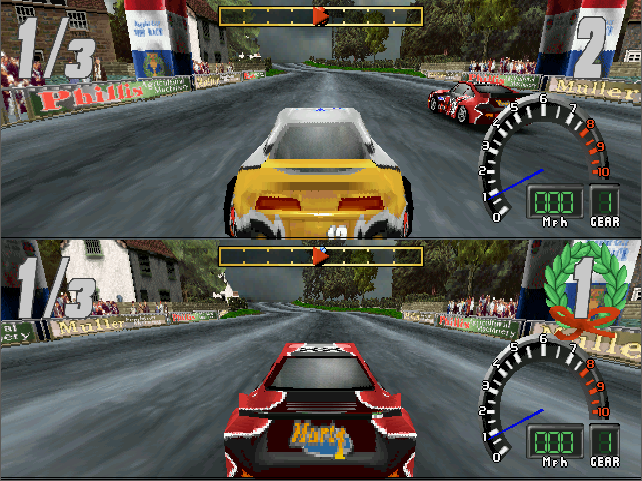 Sound card choices are plentiful in the setup utility, and in most cases there's the choice of running in mono or stereo. The in-game music tracks are played from the CD-ROM, and music and sound effects can be configured via the 'CD Player' option after pressing ESC to pause the action. One strange option is the ability to eject the disc - I didn't try putting in a regular audio CD to find out if the game would play *any* audio, but maybe that's why. The car engine sounds are decent enough, and you can hear the other cars as you approach them (or they are about to overtake), though there are few other sound effects apart from police sirens in California and cows mooing in England.
Sound card choices are plentiful in the setup utility, and in most cases there's the choice of running in mono or stereo. The in-game music tracks are played from the CD-ROM, and music and sound effects can be configured via the 'CD Player' option after pressing ESC to pause the action. One strange option is the ability to eject the disc - I didn't try putting in a regular audio CD to find out if the game would play *any* audio, but maybe that's why. The car engine sounds are decent enough, and you can hear the other cars as you approach them (or they are about to overtake), though there are few other sound effects apart from police sirens in California and cows mooing in England.
Multiplayer options are good with this game - especially the two-player split screen mode which is called 'Combat Mode'. You both get to choose a team, car, and manual/automatic transmission, followed by a track. This is just two-players head-to-head, so there are no other AI cars to race against. Other multiplayer options include playing over the direct connection with a null modem cable, or over an IPX/SPX (Novell) network.
Sound: Not bad music and sound effects - good sound card coverage. 8/10
Gameplay: Screamer 2 is a tough game, I won't deny it (perhaps a bit too tough?). The range of cars is rather limited though they do appear to be modelled on real-life vehicles. The number of tracks/locations (5) is also rather limited, but each one looks really good. The menu system works well and is good eye candy as you select your car and track, especially when in Championship mode where you see a 3D landscape view of the location! 9/10
Lastability: Belying the 'arcade' nature of this game, it's great to see car customisations when in Championship mode, and the two-player split screen option is great for playing against a friend.9/10
OVERALL: 9/10
Carmageddon (Interplay, 1997)
 For non-sensical gratuitous violence, look no further than Carmageddon. Upon its release there was furore due to its showcasing of mowing down pedestrians, so much so that the red blood needed to be changed to green, and people for aliens. This was changed back later on (probably because so many games were now depicting such things - see GTA below for another example).
For non-sensical gratuitous violence, look no further than Carmageddon. Upon its release there was furore due to its showcasing of mowing down pedestrians, so much so that the red blood needed to be changed to green, and people for aliens. This was changed back later on (probably because so many games were now depicting such things - see GTA below for another example).
For the unitiatiated, Carmageddon is an arcade-style racer with a difference. The object of the game, like most racers, is to win the race. The difference here is that you can do so by any means you like - there's the option to win by going through each and every checkpoint on the route, but you can also win by destroying all your opponents or by killing every pedestrian in the city.
 You begin the game at rank 99 and your aim is to reach rank 1. There are 17 locations to choose from, but not all are available from the start - you need to progress to unlock all of them (though a good number can be chosen right away).
You begin the game at rank 99 and your aim is to reach rank 1. There are 17 locations to choose from, but not all are available from the start - you need to progress to unlock all of them (though a good number can be chosen right away).
As you win races and/or cause carnage, you earn points which are instantly available to you to repair your car (with Backspace) or recover your car if you cannot get back on the road or onto four wheels (with Insert). At the end of the race all the points remaining get converted into a score that move you up or down in the ranking.
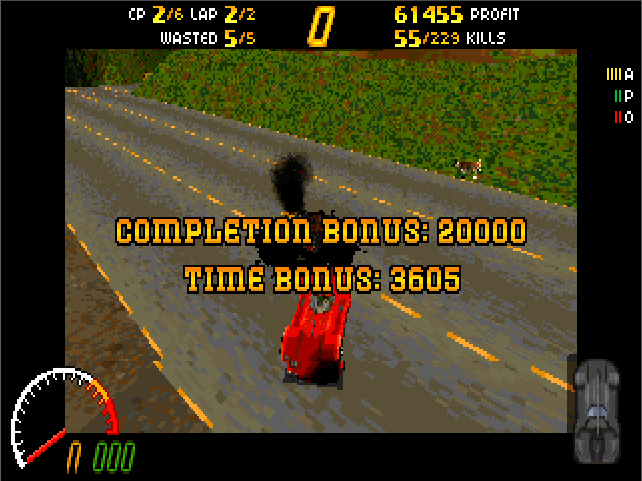 You can play from inside the cockpit, but means you'll miss out on all the craziness happening around you - it's best played in third-person view.
You can play from inside the cockpit, but means you'll miss out on all the craziness happening around you - it's best played in third-person view.
Carmageddon will run on a fairly low-end Pentium 75 with 8 MB of RAM, but it's a very graphics-intensive game, and is best run on something more like a Pentium 120 with 16 MB or 24 MB (the high-resolution mode requires at least 24 MB). There's plenty to do in the single player mode, but a great alternative is the network play which allow for up to six human players to thrash it out.
Sound: The sound in this game must be heard to be believed. Set against a thrash metal musical score (played from the CD-ROM), the effects are brutally good - squishing pedestrians and cows, metal-to-metal crunching, and the speech are engrossing and immersive. Great job! 9/10
Gameplay: There's been nothing like Carmageddon and perhaps never will be! The racing is almost forgotten about in the carnage, and the different ways in which you can win mean you have creative licence to go your own way, both literally and figuratively. The locations are huge and varied in their size and type, and the competition each have their own style and intent. 9/10
Lastability: Carmageddon has three difficulty levels which add to the progression, and with network play an option and the Splat Pack expansion, this game has a lot to offer well after you've exhausted the built-in single player modes.9/10
OVERALL: 9/10
Grand Theft Auto (BMG Interactive, 1997)
 The one that started it all, DMA Designs' Grand Theft Auto was, as you can imagine, a resounding success on its arrival in 1997.
The one that started it all, DMA Designs' Grand Theft Auto was, as you can imagine, a resounding success on its arrival in 1997.
Unlike more modern GTA games in the franchise, this one was played from a top-down/helicopter view, where the slower you drove the more zoomed-in the view became. This effect worked really well, allowing you a good amount of visibility around your current location to not crash into everything in sight (unless that was the point).
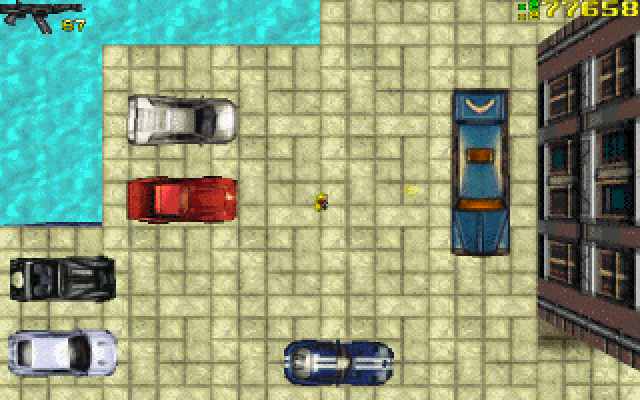 The premise in this open-world 2D driving game was to pick up jobs from telephone boxes and see them through to completion in exchange for money that you can then put into buying items like guns. Yes if the title didn't tell you, in this game you're a criminal. You could choose your own pace in the game while not on a job (jobs are often time-sensitive), stealing cars, running over pedestrians and generally causing chaos while avoiding the cops or getting beaten up if on foot.
The premise in this open-world 2D driving game was to pick up jobs from telephone boxes and see them through to completion in exchange for money that you can then put into buying items like guns. Yes if the title didn't tell you, in this game you're a criminal. You could choose your own pace in the game while not on a job (jobs are often time-sensitive), stealing cars, running over pedestrians and generally causing chaos while avoiding the cops or getting beaten up if on foot.
The three cities in the game are huge - starting in Liberty City, the other two (San Andreas and Vice City) are unlocked later once you've completed a certain set of missions. With lots of neat touches including a port area, and the city feels alive with traffic noise, music from car radios, people shouting, metro trains, honking of horns, sirens, police radio notifications, and so on.
 You start the game by choosing from eight characters, which does nothing more than change their appearance when you're walking around. Once the game has started you can choose to walk around and explore, or hit enter to comandeer the nearest vehicle. The vehicles have different characterstics - some are slow but can take more damage while others are very fast but are weak. You can also ride motorcycles, buses, and even the train (though you can't control it)!
You start the game by choosing from eight characters, which does nothing more than change their appearance when you're walking around. Once the game has started you can choose to walk around and explore, or hit enter to comandeer the nearest vehicle. The vehicles have different characterstics - some are slow but can take more damage while others are very fast but are weak. You can also ride motorcycles, buses, and even the train (though you can't control it)!
 Missions are given to you by answering a public phone box somewhere in the city. A yellow arrow in the middle of the screen gives you some guidance of the direction of your target as the crow flies, but it's up to you to navigate the streets and back alleys to get there. Some will be over a bridge so getting to know the city's layout is important to get to your destination within the time allowed.
Missions are given to you by answering a public phone box somewhere in the city. A yellow arrow in the middle of the screen gives you some guidance of the direction of your target as the crow flies, but it's up to you to navigate the streets and back alleys to get there. Some will be over a bridge so getting to know the city's layout is important to get to your destination within the time allowed.
The 90 missions in the game are one of the best aspects, with some decent knitted-together stories as you progress throug them. Some mission examples are taking a car containing drugs to a hideout, collecting cars and delivering them to the docks for 'export', killing the police chief, driving around in a bus with a bomb on-board while those onboard try to disarm it, evading the police after a diamond theft heist, and blowing up a train. There's so much variety here that you can easily forget the amount of time you've been playing.
You can see why GTA became so popular, if rather controversially. A solid driving arcade-like experience with enough variation between the vehicles and an overarching storyline to keep things interesting, it hit all the right boxes. And if that's not enough, the two expansion packs of London 1969 and London 1961 tack on even more.
Sound: The huge number of sound effects in this game is astonishing, and makes the game very atmospheric. 7/10
Gameplay: Still highly playable today, given the depth of missions and fun gameplay - sure, it's not like the 3D GTA titles, but don't let that stop you from trying the original - after all, it's what made the later ones so good! The one thing I'm not so keen on is that there's no opportunity to save your progress aside from reaching the cash total for each 'level' - this is such a shame, and makes the game frustrating to play if you like or need to pick it up and drop it in shorter stints. 7/10
Lastability: There's so many hours of gameplay built into this, with main storyline missions and sideline ones sprinkled in, and as mentioned, with two expansion packs you can keep the fun rolling. 8/10
OVERALL: 8/10
Grand Prix Legends (Papyrus, 1998)
Papyrus went all authentic on us! Well, they always were, right? Tes, but with Grand Prix Legends, released in October 1998, they got super-serious. This is a 'no holds barred' depiction of the 1967 Formula One Grand Prix, a year before they took safety to a new level with rules to make open-top racing less dangerous after far too many deaths in recent months.
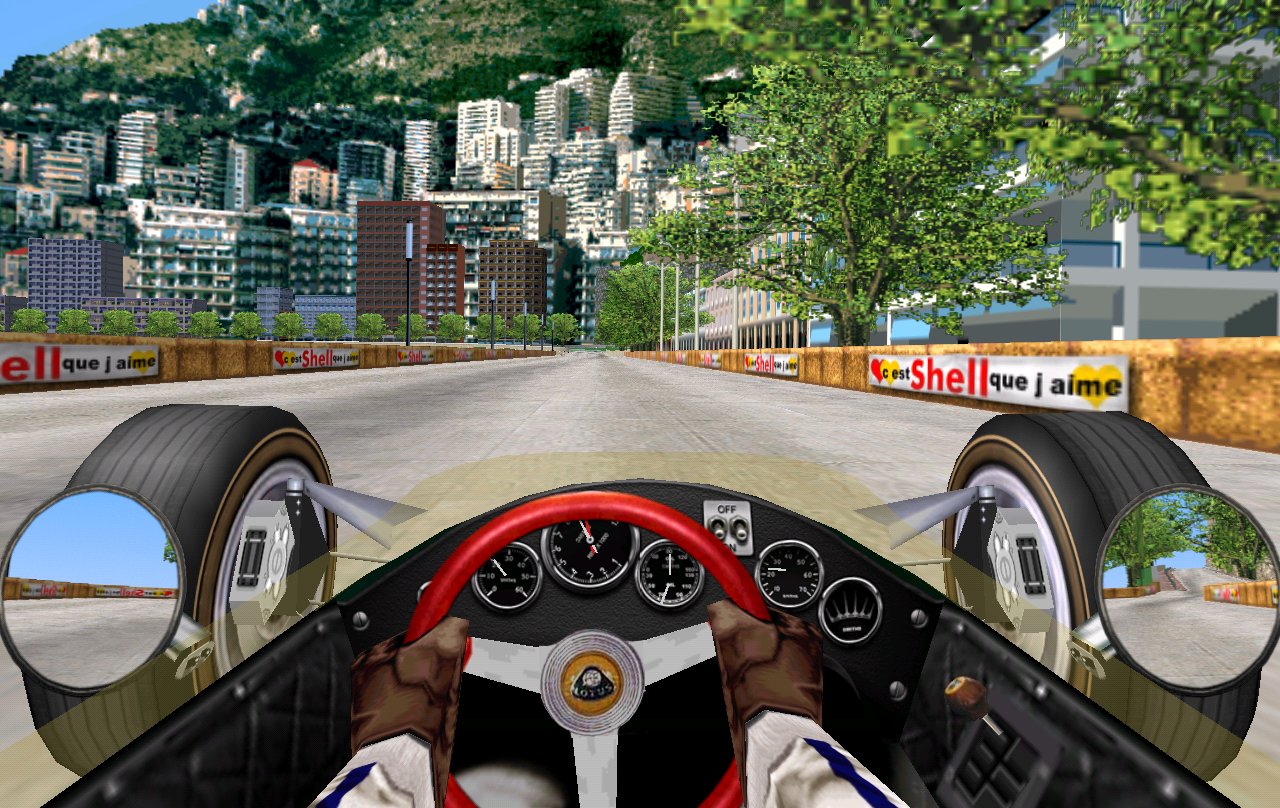 As we've come to expect from Papyrus, the game accurately models every physical aspect of a Formula 1 car of that era including engine, suspension, tyres, steering, chassis, vehicle weight, temperatures and road conditions. This is evident by the presence of physics that are rarely modelled in a computer game like using the throttle and brake for steering as the car's center of gravity shifts forward and backward.
As we've come to expect from Papyrus, the game accurately models every physical aspect of a Formula 1 car of that era including engine, suspension, tyres, steering, chassis, vehicle weight, temperatures and road conditions. This is evident by the presence of physics that are rarely modelled in a computer game like using the throttle and brake for steering as the car's center of gravity shifts forward and backward.
 This is a simulation in the truest sense - something you will need to dedicate lots of time and energy into to get the most out of it. Learn the dynamics of your car; learn the track thoroughly, understand how to tweak your car's setup to the track. Without these things, you will find GPL an exercise in frustration, though that frustration should be with yourself, as this game does everything right.
This is a simulation in the truest sense - something you will need to dedicate lots of time and energy into to get the most out of it. Learn the dynamics of your car; learn the track thoroughly, understand how to tweak your car's setup to the track. Without these things, you will find GPL an exercise in frustration, though that frustration should be with yourself, as this game does everything right.
GPL was the pinnacle of graphical fidelity in a racing simulation for 1998, supporting resolutions up to 800 x 600 (though the main menus are all in 640 x 480). Later aftermarket improvements enhanced this up to 1600 x 1200. The trees really look like trees and cast shadows on the track, the view in your wing mirrors is as photorealistic as what you see out in front, the track edges are lined with spectators, period-correct advertising billboards, gantries and bridges adorn the track and there are even homes with cars in the driveway.
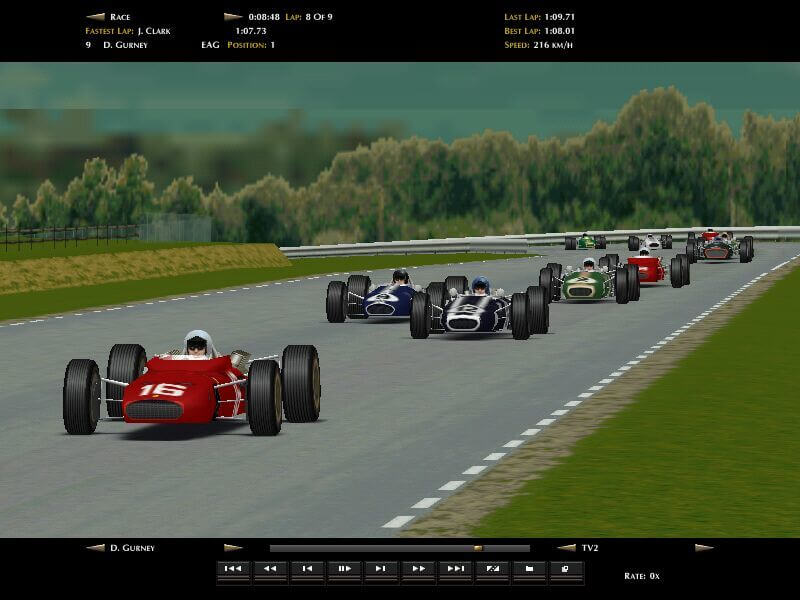 The audio is so breathtaking you can almost smell the thrills of 60's Formula One - the cars, the pitlane, burning rubber, hot engine oil. The level of engagement in this game is really something to behold.
The audio is so breathtaking you can almost smell the thrills of 60's Formula One - the cars, the pitlane, burning rubber, hot engine oil. The level of engagement in this game is really something to behold.
The only let-down with Grand Prix Legends was that you needed a crazy-fast PC to be able to run it. The game is locked to 36 frames per second, though at the time many were lucky if they hit half that number. The game run under Windows 95, and required a minimum of a Pentium 90 with 16 MB of RAM. A fast SVGA graphics card was a must, and if you wanted hardware 3D acceleration you needed a Rendition Verite or 3dfx card. It's definitely recommended to run in on something more like a Pentium 233 with 32 MB of RAM.
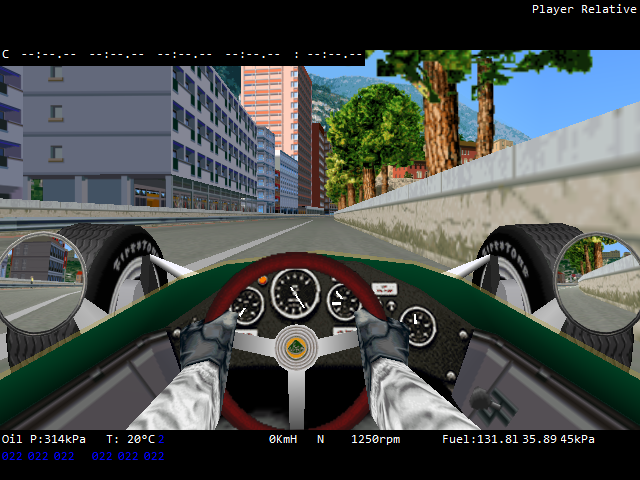 The game's AI is designed to make it easier for entry-level racers to compete against the other drivers and gradually become more difficult as you improve. That's not to say it's easy - far from it, but it does have a 'scaling' that's better than most other racing sims.
The game's AI is designed to make it easier for entry-level racers to compete against the other drivers and gradually become more difficult as you improve. That's not to say it's easy - far from it, but it does have a 'scaling' that's better than most other racing sims.
The damage model built into GPL is also realistic. Given this era when Formula One cars weren't the reliable things they are today, you could easily find yourself retiring from a race for any number of reasons - not just due to a collision. There's no communication with your pit crew apart from looking at the chalk board they hold out as you past the start/finish straight, and you can't tweak your suspension setup from within the cockpit.
Multiplayer support was included in the game from the start with either 2-player modem link or up to 8 players over a local network (IPX/SPX, aka Novell only).
The gaming community really rallied around GPL, with a number of third-party patches that utterly transform the game from its original form. Some of these patches include graphical updates, new tracks and enhanced versions of those found in the original, new cars and engines, and entire championship season make-ups of the era.
Sound: Authentic engine sounds, tyre squeal, and bone-crushing crash noise, GPL has it all in the sound department. 10/10
Gameplay: The level of realism in this game might a step to far for some, but if accuracy is your thing and you have time to learn how to really handle an F1 car of the 1960s, this game will have you hooked. 10/10
Lastability: As if a full championship season wasn't enough, the third-party add-ons you can download for GPL is simply astonishing. These can almost replace everything apart from the original game engine to bring the game up to the standard of a modern-day racing sim. 10/10
OVERALL: 10/10
So let's do a quick look at the podium for the 1996-1998 period...
|
|
|
|
|
|
This go-around we've seen screen resolutions rise to 800 x 600 and 24-bit colour depths. Seminal titles like Grand Prix Legends, Carmageddon and Grand Theft Auto introduced us to something innovative while the other front runners here built on what was already tremendous: NASCAR Racing 2, Grand Prix 2, and Screamer 2.
Wow, what a journey this has been! As I wrap up this four-part article, it's amazing to look back over the 38 driving games and see just how far the PC driving/racing genre has come in 11 years. What's most interesting is that each of the periods I defined at the start offer a handful of games that are still great fun to pick up and play today. In some cases you need to put on your rose-tinted glasses and cast your mind back to the fact that 'this was cutting edge when it came out' and just enjoy it for what it was.
Here are my personal favourites from each of them:
| The Early Years (1987 - 1989) | Grand Prix Circuit, Indianapolis 500 |
| The Dawn of 3D (1990 - 1992) | Formula One Grand Prix (World Circuit), Test Drive III: The Passion |
| The Mid-Nineties (1993 - 1995) | Destruction Derby, Indycar Racing II |
| The Pinnacle (1996 - 1998) | Carmageddon, Grand Prix 2 |
What are your faves, and why? Feel free to get in touch with your comments!





